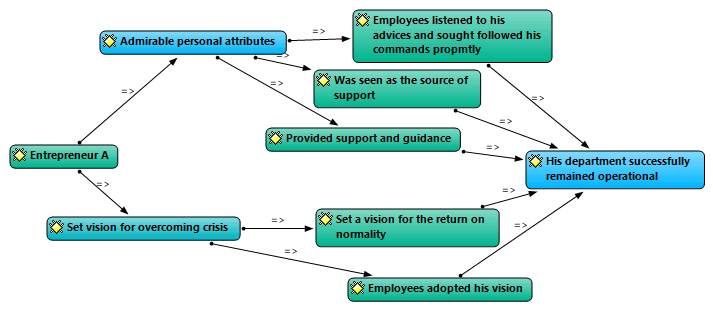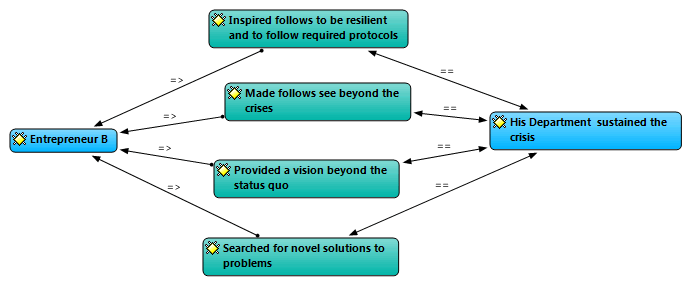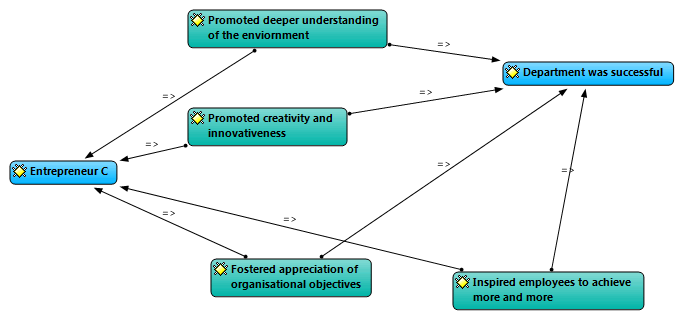Research Article: 2021 Vol: 20 Issue: 6S
Leadership Qualities for Successful Entrepreneurship in Disruptive Contexts
Samson Nambei Asoba, Walter Sisulu University
Nteboheng Patricia Mefi, Walter Sisulu University
Abstract
This study was formulated to explore the leadership qualities that are essential for successful entrepreneurship in the context of disruptions arising from the 4IR and the Covid-19 pandemic. The qualitative research design was adopted to collect and analyse relevant data to establish the qualities of the charismatic, transformational, visionary and transactional entrepreneurs that enable sustenance during difficult times. A case study of a successful entrepreneurial venture was reviewed. The evidence found from this study demonstrated the the charismatic, visionary and transformational leadership traits resulted in notable entrepreneurial performance. Entrepreneurs were recommended to strengthen their visionary, transformational and charismatic traits for the success of their ventures.
Keywords
Leadership, Visionary, Charisma, Transformational, Entrepreneurship
Introduction
Leadership and successful entrepreneurship are intertwined (Esmer & Dayi, 2017). Despite the recognition that entrepreneurship is critical in many economies, entrrepreneurs face competition from established enterprises and they have a high risk of failure that threaten their ventures (Hg & Kee, 2017). Following these observations, there appears to be greater need for effective leadership traits among entrepreneurs for viabrant economic activity in any nation. This study considers these arguments in the light of the present economic landscape which is characterized by technological disruptions associated with the Fourth Industrial Revolution (4IR) as well as the disturbances linked to the Covid-19 pandemic. Leadership in organisations is generally viewed as an action of influencing others to behave in a certain way. For long, researchers have been interested in how leaders influence others. Four theories have gained significant acceptance in explaining how leaders influence their followers. These are; (1) charismatic leadership theory (2) transformational leadership theory (3) visionary and transactional theories. These four theories of leadership dominate the literature on the manner in which leaders influence their followers. In order to make a clear analysis of the above four theories in relation to entrepreneurship, it is essential to commence by making concise definitions of these theories. ‘Charisma’ is a set of personal attributes that creates awe, admiration and a compelling force on followers (Paschen & Dihsmaie, 2014). Consequently, charismatic theories posit that leaders influence their followers using their strong compelling personality and other personal attributes. In contrast, the visionary leader uses a powerful vision and it is this vision that influence followers. The purpose of this paper was to explore the leadership traits that are essential for successful entrepreneurship in the context of disruptions arising from the 4IR and the Covid-19 pandemic. It also considers how entrepreneurs whose behaviours are oriented to a certain theory create advantages or disadvantages for their organisations. The paper begins with a review of the concept of ‘charisma’ and outlines the foundations of charismatic theory including the general behaviours that characterise charismatic leadership. After the theoretical review, this was linked to entrepreneurs. A consideration of visionary, transformational and transactional leadership theories then follows and a similar order of review is made.
Literature Review
Charismatic entrepreneurs tend to possess certain traits that are likely to charm all stakeholders they interact with including customers and suppliers and employees. In discussing the charismatic leadership theory, Bass (cited in Judge & Piccolo, 2004:755) describes charisma as the degree to which a leader behaves in admirable ways that cause followers to identify with the leader. Charismatic entrepreneurs are likely to appeal to followers, customers, suppliers and other stakeholders on an emotional level. Judge and Piccolo (2004) also explain that Weber (1921/1947) was the first to reveal the nature and impact of charismatic leadership for organizations. The charismatic leadership theory was later popularized in House’s (1977) who used the concept in contemporary organizational research. Since then there have been many studies of charismatic leadership (House, Spangler & Woycke, 1991; Howell & Frost, 1989; Shamir, Zakay, Breinin & Popper, 1998). The practical sense of charismatic entrepreneurs is the situation where stakeholders tend to imitate certain behaviours and traits that the leader displays. Many times people have witnessed followers imitating a leader’s communication accent, dressing style, postures and facial expressions. Charismatic entrepreneurs, therefore charm others with a strong personality, self-confidence and many other unique attributes. In organisations, we can conclude that a charismatic leader with great work ethics that are in line with the goals of the organisation is likely to influence followers in a way that further the organisational goals as well. The opposite situation can also be true – when a charismatic leader no longer advances the dictates of organisational values but appears to be more aligned to personal interest then this will also impact on the behaviour of followers. Considering visionary entrepreneur, Kantabutra & Avery (2006) provide that visionary leaders engage in four key actions which are: vision development, articulation, communication and development. Within organisations, a vision is a future desired state. Visionary entrepreneurs are likely to set out a clear vision and create an emotional bond between followers and the vision. Yukl (2010) argue that visionary leadership require followers to participate rather than to be passive. Followers of visionary entrepreneurs, thus, depend on the leader’s vision to make important decisions and to take initiatives in the organisation. This theory of leadership originated from the scholarly work of Burns (1978). In the past 20 years, a substantial body of research has accumulated on transformational leadership theory (Judge & Piccolo, 2004).
The transformational leadership theory has also received notable attention in the literature. This theory of leadership originated from the scholarly work of (Burns, 1978). In the past 20 years, a substantial body of research has accumulated on transformational leadership theory (Judge & Piccolo, 2004). The fact that transformational leaders want their subordinates to perform exceptionally well and to supersede performance means that such leaders significantly lead to human capital development, increased performance and competitive advantage (Birasnav, 2011). Transformational entrepreneurs contribute to firm innovation, organizational learning, and employees’ creativity skills (De Jong & Hartog, 2007). The behaviors of Transformational entrepreneurs enhance followers’ intrinsic motivation which in turn leads to greater creativity of followers. Transformational entrepreneurs-, who exhibit creative behavior, inspire followers with a compelling vision, stimulate followers to challenge assumptions and think for themselves, and who respect their followers- are able to engage their teams and unleash their full. Some entrepreneurs are the ‘do this and I do that for you’ type. They influence through the idea of exchanging one thing for another. These entrepreneurs follow the dictates of the transactional leadership theory. Judge & Piccolo (2004) argue that transactional leaders focus on the proper exchange of resources and the transactional leader gives followers something they want in exchange for something the leader wants. Thus transactional leadership theory is based on the premise that a leader influences follows by offering something in exchange for certain follower performance. In practice such entrepreneurs see their role to follows as that of managing a transaction in which they request certain performance behaviours which they then reward financially, non-financially or simply through recognition.
Methodology
The qualitative research approach was adopted to collect data relevant for the study. Qualitative researchers rely on the collection of subjective non-numeric data in natural settings that is relevant to study objectives (Hancock, Ockleford & Windridge, 2009). The study was set to study the behaviours and way of life of entrepreneurs within their organisations and consider the leadership traits and qualities that enhance their effectiveness. As such an ethnographical research design was adopted for the study. Williams (2007) explains that ethnography involves the collection of observational studies over a relatively long period of time and aims at identifying the culture, norms and behaviours of a group of people. In line with the ethnographical research design, observations of the leaders of a successful entrepreneur enterprise in Cape Town were made and records were kept on the traits, qualities and behaviours of the leaders. Photographs of previous key events presided by the entrepreneurs were also considered for analysis. The entrepreneurial venture (which could not be named for ethical reasons) was selected from the Drinks and Beverage Bottling industry. It had a product based departmentalization structure with four flavours of a fruit drink led by a team of four entrepreneurs (A, B, C and D). These four flavours (orange, apple, grape and mango) were operated as independent departments which were overseen by different entrepreneur leaders with different leadership styles. Although the four flavours were led by different leaders, they were all successfully contributing an almost equal (25%) of total orgainsational sales. Entrepreneur A led the Orange flavour department, entrepreneur B led the Apple department and entrepreneur C led the Grapes department and entrepreneur D led the Mango flavour Department.
Findings and Discussion
Leadership Qualities of Entrepreneur A (Charismatic Leader) and the Success of the Enterprise during the Covid-19 Disturbances
Charismatic leadership traits were noticeable in entrepreneur A. The argument that leaders are born somehow also matched entrepreneur A. He had a physical presence and perhaps complemented this with health habits in both food and fitness sessions in one of the most expensive gyms in Cape Town City Centre. Most of his subordinates though that he was very fit and any advice that he gave on personal wellbeing were listened to. He had vast industry experience and everyone admired his technical knowledge of bottling, packaging, branding and marketing of the Apple flavour department. He enjoyed holding frequent meetings which were often of high quality and well prepared for. Although he was naturally keen and careful in dressing, each time he came for a meeting, he put on extra effort on his dressing. He communicated very eloquently and with a foreign (American) accent although his mother tongue is isiXhosa. Whenever he spoke in isiXhosa, he did so in a manner that strikes admiration. His subordinates enjoyed listening to him and anyone who argued against him found it difficult to gain the support of others. As a result, work in the Apple Department was done in such a way as to match Mr Entrepreneur A, to surpass him or obtain his approval. The success of the Apple Department was, therefore, largely because of the admired personality and behavioural attributes of the leader entrepreneur A. Subordinates were in awe and were heavily influenced by him in both verbal and non-verbal communication channels. Indeed some subordinates imitated how he speaks, laughs, stresses points, talks and even dress. How entrepreneur A influenced the success of the venture is shown in Figure 1.
There was evidence in this study that charismatic leaders motivate and encourage people to work in collaboration for achieving a common cause. For succeeding in their mission and vision, charismatic leaders make their priorities to learn from mistakes so that they are able to achieve success in their life. Cohesiveness is achieved in the organization by Charismatic leaders who have clear purpose to achieve things; moreover the followers also have clear purpose to achieve in their life. Critical theorist have, however argued that charismatic leaders tend to be narcissistic and can sometimes lead the organisation aside (Boone, 2006). When considering the dangers of charismatic leaders in summary: Arrogance may prevail because of charismatic style of leadership. It may also happen that organization may depend heavily upon such charismatic leaders and at the time sudden demise of such leaders or due to retirement, the organization may suffer a lot. Unresponsiveness towards their subordinates or constituents is also seen sometimes in charismatic leaders. Learning form mistakes maybe a far cry for such charismatic leaders. Sometimes such type leaders may think that they are above rules, regulations and laws because of which they may commit errors and violations.
Leadership Qualities of Entrepreneur B (Visionary Leader) and the Success of the Enterprise during the Covid-19 Disturbances
Entrepreneur B, the Grapes flavour departmental leader, was well travelled and very imaginative. He had pictures of some of the best bottling and packaging operations from some of the best performing companies in developed countries such as the United Kingdom, United States of America, Germany, Russia and Switzerland. He always stressed that his vision is to raise organisational standards to the level that he has seen in the developed countries. Subordinates admire his vision and seem to be inspired by his imagination and vision. As a result, performance of the Grape flavour has been good and all subordinates follow the visions set entrepreneur B. The leadership traits of entrepreneur B and how they influenced performance is shown in Figure 2
Leadership Qualities of Entrepreneur C (Charismatic Leader) and the Success of the Enterprise during the Covid-19 Disturbances
As noted earlier, the transformational leader seeks to engage followers in such a way that they seek to supersedes their current performance. The Covid-19 crisis presents a good case for transformational leadership. The fateful pandemic led to the collapse of many industries and affected many employees and resulted in serious productivity problems due to low worker morale, a long period of closure below capacity operation and bad publicity. Entrepreneur C was very influential with her creativity and innovative drive. When subordinates enter her office with queries, they were asked to look on the walls of her office where three big boards’s hung inscribed with the question, ‘What have you done better today, far much better than yesterday.’ She always emphasised on performing beyond expectations, beating personal benchmarks, changing the status quo through creative ways and being innovative. Everyone in the department had adopted her philosophy that the best is always attainable through efforts to achieve the best possible. Subordinates were asked each day to brainstorm new ways of doing things and to always search for the best ways to achieve the best. Figure 3 shows the leadership traits of Entrepreneur C and how this influenced performance
Entrepreneur D who was more of a transactional leader really changed style and adopted a hybrid of the leadership styles illustrated above. Entrepreneur D who led the orange department used be described as a transactional leader. To him, the employment relationship gives maximum benefits if a ‘tit for tat’ principle of performance and rewards is followed. He used to enjoy sitting down with every employee to set targets and agree on something favourable that he will offer to the subordinate if the agreed performance is reached. He used to ask everyone in the department to do something good and he will offer something good in return. To him, leadership was a transaction of performance and rewards. Certificates, awards, financial and non-financial benefits are offered to subordinates who perform to a certain level.
Conclusion
This paper has given long lasting insights into how leadership qualities of entrepreneurs in turbulent times influence their followers and how this influence impacts on orgainsational success. The study seemed to suggest that there is no one best style which is better than another but the charismatic, transformational and visionary leadership styles seemed to have notable impact in influencing successful entrepreneurship. It has also been realized that leaders influence their followers from the perspective of all the four theories that is they can be charismatic, visionary, transformational and transactional as well.
Recommendations
The findings of this suggest that there is need for entrepreneurs to adopt the right leadership traits during turbulent times for them to remain viable. Leaders are recommended to attend leadership coaching and training programs that equips them with effective transformational, charismatic, visionary and transactional leadership traits for the success of their ventures.
References
- Paschen, M., & Dihsmaier, E. (2014). The psychology of human leadership. Heidelberg: Springer.
- Judge, T.A., & Piccolo, R.F. (2004). Transformational and transactional leadership: a meta-analytic test of their relative validity. Journal of applied psychology, 89(5), 755-763.
- Birasnav, M., Rangnekar, S., & Dalpati, A. (2011). Transformational leadership and human capital benefits: The role of knowledge management. Leadership & Organization Development Journal, 32(2), 106-126.
- De Jong, J.P.J., & Den Hartog, D.N. (2007).How leaders influence employees’ innovative behaviour. European Journal of Innovation Management, 10(1), 41-64.
- Yukl. G. (2010). Leadership in organisations. Global edition (7th edition). Upper Saddle River: Pearson.
- Higgs, M. (2009). The good, the bad and the ugly: Leadership and narcissism. Journal of Change Management, 9(2), 165-178.
- Boone, M. (2006). The dark side of transformational leadership. Journal of philosophy and history of education, 14.
- Hancock, B., Ockleford, E., & Windridge. (2009). An Introduction to qualitative research. Nottingham: The NIHR Research Design Service for Yorkshire & the Humber.


